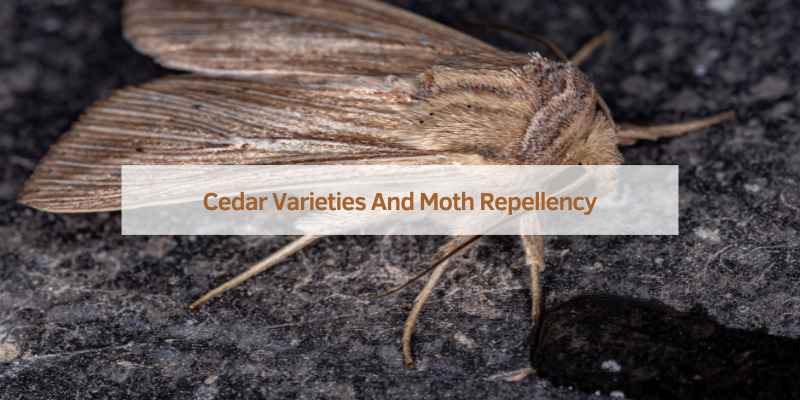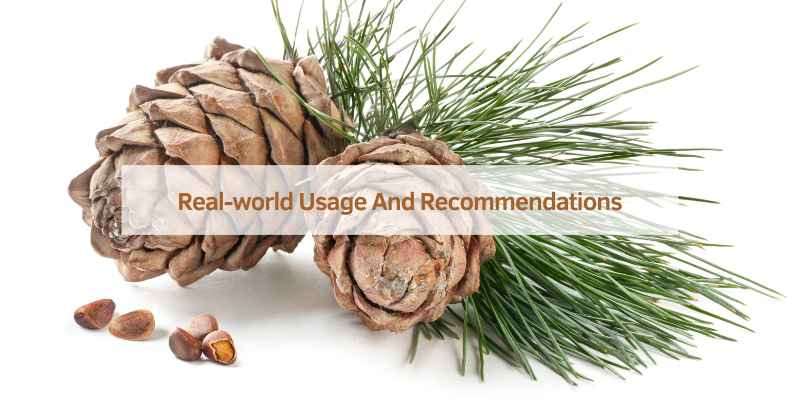The best cedar for repelling moths is Eastern Red Cedar, which is actually a type of juniper tree. The oils produced by Eastern Red Cedar have similar qualities to real cedar wood oil, making it effective in repelling moths.
Unlike traditional mothballs, cedar wood balls are a safe and natural alternative that can be used in drawers, closets, and other storage areas to keep moths away. In addition to its effectiveness, cedar wood is also sustainable and adds a pleasant fragrance to your storage spaces.
Using cedar wood for moth control is a popular and eco-friendly solution.
Cedar Varieties And Moth Repellency
When it comes to repelling moths, cedar is a popular choice due to its natural ability to deter these pesky insects. Different varieties of cedar offer varying levels of effectiveness in moth repellency.
The Science Behind Cedar And Moths
Eastern Red Cedar (Juniperus virginiana), while not a true cedar, is known for its moth-repelling properties. The oils produced by Juniperus virginiana share similar qualities with real cedar wood oil, making it an effective moth repellent.
Comparing Cedar Types: Which Is Most Effective?
| Cedar Variety | Effectiveness in Moth Repellency |
|---|---|
| Eastern Red Cedar (Juniperus virginiana) | Highly effective due to similar chemical makeup to real cedar wood oil |
| Aromatic Red Cedar Blocks | Natural indoor insect repellent for clothes storage |
| Cedar Rings and Blocks | Effective for moth prevention in closets and drawers |
- Using cedar wood for moth control is a natural and sustainable solution.
- Cedar offers a fresh forest fragrance while keeping moths at bay.
- Moths dislike the scent of cedar, making it an ideal repellent for storage areas.
Cedar wood products, such as balls and blocks, provide a safe and non-toxic alternative to traditional mothballs. They not only repel moths effectively but also add a pleasant aroma to your storage spaces.

The Eastern Red Cedar Factor
The Eastern Red Cedar, also known as Juniperus virginiana, is a type of juniper that produces oils with similar qualities to cedar wood oil. These oils have the ability to repel moths, making it an effective natural solution for moth control.
Consider using cedar wood products like cedar balls, planks, or blocks to keep moths away from your clothes and pantry.
Chemical Composition Of Juniperus Virginiana
Eastern Red Cedar, scientifically known as Juniperus virginiana, is not a true cedar tree but a type of juniper. However, the chemical composition of the oils produced by Juniperus virginiana shares similar qualities with real cedar wood oil, including the ability to repel moths. These oils contain natural compounds such as thujopsene, cedrol, and alpha-cedrene, which are responsible for its aromatic scent and moth-repellent properties.
Myth Vs. Reality: Does Eastern Red Cedar Kill Moths?
There is a common misconception that Eastern Red Cedar can directly kill moths. However, the reality is that Eastern Red Cedar acts as a natural deterrent rather than a lethal force against moths. The strong aroma of the cedar wood oil emitted by the tree disrupts the moths’ ability to detect pheromones and navigate effectively, discouraging them from entering or laying eggs in areas protected by cedar.
While cedar wood is effective in repelling moths, it is important to note that it does not eradicate existing moth infestations. It serves as a preventive measure and a long-term solution for keeping moths at bay. Incorporating Eastern Red Cedar products, such as cedar balls, cedar blocks, or cedar-lined closets, can help protect your clothes, linens, and other susceptible items from moth damage.
Summary
In summary, Eastern Red Cedar, or Juniperus virginiana, contains natural compounds that mimic the properties of true cedar wood oil, making it an effective moth repellent. However, it is essential to understand that cedar does not directly kill moths but acts as a deterrent by interfering with their pheromone detection system. By utilizing cedar products in your storage areas, you can create an inhospitable environment for moths and protect your belongings from potential damage.
Cedar Products On The Market
When it comes to dealing with moths, various cedar products are available on the market to help prevent infestations and protect your belongings. From cedar blocks to cedar planks and chips, these products offer a natural and effective solution for moth control.
Cedar Blocks Vs. Mothballs: Safety And Efficiency
Cedar blocks are a safe and efficient alternative to traditional mothballs. Made from aromatic cedar wood, these blocks release a pleasant scent while safely repelling moths. On the other hand, mothballs contain toxic chemicals that may pose risks to children and pets.
Cedar Planks And Chips: Aesthetic And Functional
Cedar planks and chips not only serve as functional moth repellents but also add a touch of natural beauty to your storage spaces. The aromatic properties of cedar make it an ideal choice for protecting clothes and linens from moth damage.
Cedar Application Techniques
When it comes to protecting your clothes and linens from moths, cedar is a natural and effective solution. Understanding the best cedar application techniques can help you maximize its moth-repelling benefits. From strategic placement to refresh and maintenance tips, here’s how to make the most of cedar repellents.
Strategic Placement For Maximum Effect
Strategically placing cedar products in your closets, drawers, and storage containers is crucial for maximum moth-repelling effect. Consider the following tips for strategic placement:
- Closets: Hang cedar blocks or sachets in your closets to create a moth-repelling barrier around your clothing.
- Drawers: Place cedar balls or blocks in your drawers to protect folded garments from moth damage.
- Storage Containers: Add cedar planks or chips to storage containers to safeguard seasonal clothing and linens.
Refresh And Maintenance Tips For Cedar Repellents
To ensure the continued effectiveness of cedar repellents, it’s essential to refresh and maintain them regularly. Here are some tips for refreshing and maintaining cedar products:
- Renew Scent: Lightly sand cedar blocks or balls to renew their aromatic scent and enhance their moth-repelling properties.
- Exposure to Sunlight: Periodically expose cedar products to sunlight to reactivate their natural oils and extend their repellent lifespan.
- Replacement: Over time, cedar products may lose their potency. Consider replacing them annually to ensure continuous moth protection.
Non-cedar Alternatives
While cedar is a popular choice for repelling moths, there are several non-cedar alternatives that are worth considering. These natural options offer a pleasant fragrance while effectively deterring moths from infesting your clothing and storage areas.
Lavender
Lavender is a beautifully fragrant herb that is known for its calming aroma. It also acts as a natural moth repellent, making it a great alternative to cedar. The strong scent of lavender is highly effective in keeping moths at bay, and it can be used in the form of sachets, essential oils, or dried lavender bunches.
Peppermint
Peppermint is another powerful natural repellent for moths. Its strong and refreshing scent is disliked by moths, making it an excellent choice for protecting your clothing and linens. Peppermint oil can be applied to cotton balls or used in spray form to create a moth-deterring barrier in your storage areas.
Other Natural Repellents
In addition to lavender and peppermint, there are several other natural repellents that can be effective in warding off moths. These include rosemary, thyme, cloves, and cinnamon. These aromatic options not only keep moths away but also add a pleasant fragrance to your storage spaces.
The Lifecycle Of Cedar Repellency
The best cedar for moth repellency is Eastern Red Cedar (Juniperus virginiana), known for its ability to repel moths due to the chemical makeup of its oils. Unlike traditional mothballs, cedar wood balls offer a safe and fresh-smelling solution for drawers, closets, and other storage areas.
Cedarwood is a natural and effective solution for treating and preventing moth infestations both inside and outside the home.
How Long Will Cedar Keep Moths At Bay?
Cedar wood is a natural moth repellent and has been used for centuries to protect clothing and other items from moth damage. But how long does cedar actually keep moths at bay? The answer depends on a few factors, including the type of cedar product you’re using, the environment in which it’s placed, and the severity of the moth infestation.
Cedar blocks and balls can keep moths away for up to six months to a year, depending on the conditions. Cedar oil sprays and sachets may need to be refreshed more often, typically every three to six months. However, it’s important to note that cedar’s effectiveness can diminish over time, especially if it’s exposed to air and light.
When To Replace Or Refresh Cedar Products
If you notice that moths are starting to appear despite using cedar products, it may be time to replace or refresh them. Signs that cedar has lost its potency include a weaker scent, visible signs of wear and tear, or a buildup of dust or debris.
To refresh cedar blocks or balls, simply sand them lightly with fine-grit sandpaper to expose fresh wood and restore the scent. Cedar sachets can be refreshed by adding a few drops of cedar oil to the fabric or replacing the sachet altogether. If your cedar products are severely damaged or have lost their scent completely, it’s time to replace them.
In general, it’s a good idea to refresh or replace cedar products every six months to a year to ensure they’re still effective at repelling moths. With proper care and maintenance, cedar can provide long-lasting protection against moth damage and keep your clothes and other items safe and fresh-smelling.
Real-world Usage And Recommendations
For effective moth repellent, consider using Eastern Red Cedar, which has similar qualities to real cedar wood oil. Unlike traditional mothballs, cedar wood balls are safe and emit a fresh forest fragrance, making them a safer and more pleasant option for moth control.
Cedar wood is a natural and sustainable solution for both indoor and outdoor use, providing a fragrant and effective defense against moths.
Consumer Reviews: Best Cedar Products For Moths
When it comes to selecting the best cedar products for moth prevention, consumer reviews play a crucial role. Real-world experiences and feedback from users can offer valuable insights into the effectiveness of different cedar solutions in combating moth infestations.
Expert Picks: Top Cedar Solutions For Your Home
Expert recommendations for the top cedar solutions for moth prevention can provide homeowners with trusted and reliable options to safeguard their belongings from moth damage. These picks are based on extensive research and industry expertise, ensuring that consumers have access to the most effective cedar products on the market.

Environmental And Safety Considerations
When considering which type of cedar is best for moths, it’s crucial to take into account the environmental and safety aspects. Utilizing cedar for moth prevention not only offers natural and effective protection for your belongings but also comes with certain environmental and safety considerations.
The Sustainability Of Cedar
Cedar is a sustainable choice for moth prevention due to its natural properties. It is renewable and biodegradable, making it an eco-friendly option for those looking to avoid chemical-based moth deterrents. By opting for cedar, you can contribute to environmental preservation while protecting your clothes and other items from moths.
Health Implications Of Using Cedar In Your Home
When using cedar for moth prevention, it’s important to consider the potential health implications. Unlike traditional mothballs that contain toxic chemicals, cedar offers a natural and safe alternative. It is non-toxic and safe for use around children and pets, providing a fresh forest fragrance that enhances the freshness of your storage areas without posing any health risks.
Frequently Asked Questions
What Kind Of Cedar Repels Moths?
Eastern Red Cedar trees, not true cedars, repel moths due to their oil’s moth-repelling properties.
Are Cedar Balls The Same As Moth Balls?
No, cedar balls are not the same as moth balls. Cedar balls are made from cedar wood and are a natural and safe alternative to traditional moth balls, which contain toxic chemicals. Cedar balls repel moths and offer a fresh forest fragrance, making them suitable for use in drawers, closets, and other storage areas.
What Wood Is Good For Moths?
Cedar wood, like Eastern Red Cedar, is effective in repelling moths naturally, making it a good choice for moth control.
Will Cedar Get Rid Of Pantry Moths?
Yes, cedar can help get rid of pantry moths. Moths dislike the odor of cedar, so using cedar blocks, planks, or chips in your pantry can repel them. Eastern Red Cedar is particularly effective as it has similar qualities to real cedar wood oil and is a natural and safe solution.
Avoid using toxic mothballs and opt for natural cedar wood instead.
Conclusion
When it comes to choosing the best cedar for moths, Eastern Red Cedar stands out. Its oils effectively repel moths, making it a natural and safe option. Using cedar wood is a sustainable and fragrant way to prevent moth infestations in your home.


